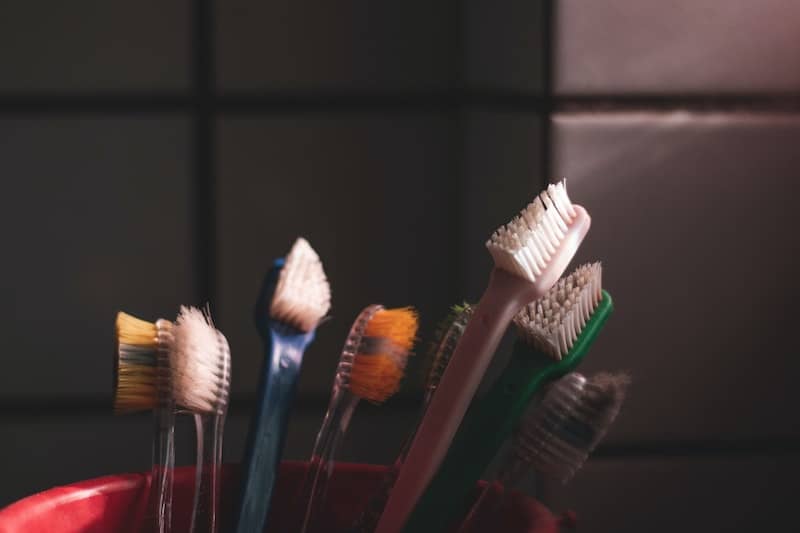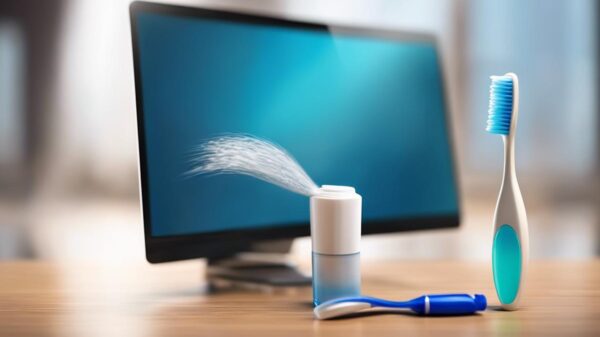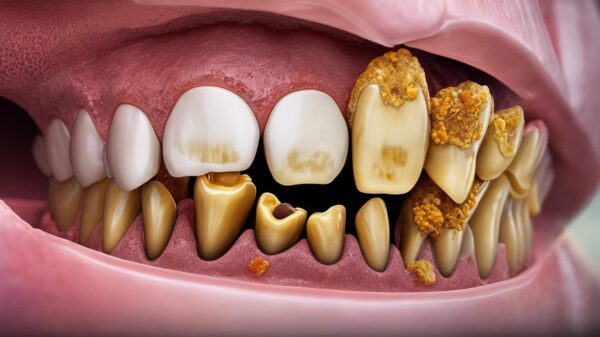Can Toothbrushes Get Moldy?
The last thing you want to think about is how you could be putting a moldy toothbrush in your mouth; however, mold can pose a risk to your health and the health of others. Before you go brush your teeth, read this article to find out whether or not toothbrushes can get moldy.
Can toothbrushes get moldy? Toothbrushes can in fact get moldy. Mold can form on toothbrushes that aren’t stored with proper airflow. Mold can also form on toothbrushes that are stored in a cup rather than a bottomless holder. The water from the brush collects at the bottom of the cup, creating a breeding ground for mold. Old toothbrushes are also more susceptible to mold growth.
Well, that’s disgusting. Luckily, there are some ways you can protect your toothbrush against mold and put your mind at ease. This article will walk you through how to take better care of your toothbrush so that it doesn’t get moldy. Keep reading to learn more:
How to Tell If Your Toothbrush is Getting Moldy
Mold on your toothbrush can be both visible and invisible to the human eye. With many bristles and grooves, mold can hind in your toothbrush at microscopic levels. However, it can also appear visible as black goop or pink slime. Many times, mold may form visibly on the bottom of your brush due to being stored in a cup.
Sometimes your toothbrush will smell bad once mold has begun to form. If you see (or smell) mold anywhere on your toothbrush, even at the opposite end of the bristles, the best thing to do is just throw it away and replace it.
If you’re nervous about mold on your toothbrush that you are unaware of, you can always get a new toothbrush. It is recommended that you change your toothbrush every three months or sooner if the bristles start to fray. Older toothbrushes are more likely to develop mold as they are more porous than new brushes and water cling to them more easily.
Ways to Prevent Mold From Forming On Your Toothbrush
There are many easy and simple ways to protect your toothbrush from mold. If you are worried about mold forming on your toothbrush, follow these steps:
Thoroughly Rinse Your Toothbrush After Each Use
Unbeknownst to you, there are many different types of microscopic bacteria living in your mouth. In fact, you can have over 1 million bacteria living on one tooth at a time. Now that’s a lot of germs. When you brush your teeth, these bacteria are transferred to your toothbrush, where they will stay until the brush is thoroughly rinsed off.
Once the bacteria is on your toothbrush, it can help aid in the development of mold and other nasty germs. To avoid this, thoroughly rinse your toothbrush off with water after each use. Put the toothbrush under running water from the faucet; the running water will help to remove the bacteria and clean the brush.
Thoroughly Remove Water From Your Toothbrush After Each Use
Another thing you should incorporate into your daily brushing is once you’ve rinsed your toothbrush with water, you then need to effectively remove as much water as you can from the toothbrush. This can be done by tapping the toothbrush against the side of the sink a few times.
The reason you want to remove excess water from your toothbrush is that water is the breeding ground for bacteria and mold. Mold will only form in areas that are damp with moisture. To avoid mold forming on your toothbrush, be sure to get rid of excess water before storing the brush.
Don’t Store Your Toothbrush in a Cup
 Storing your toothbrush in a cup is one method that can actually cause mold to form on your toothbrush. When a toothbrush is stored in a cup, all of the water remaining on the toothbrush will drip down and gather at the bottom of the cup. These cups can go weeks without being cleaned, and before you notice it, you see a dark goop beginning to form in the cup and on the bottom of your toothbrush.
Storing your toothbrush in a cup is one method that can actually cause mold to form on your toothbrush. When a toothbrush is stored in a cup, all of the water remaining on the toothbrush will drip down and gather at the bottom of the cup. These cups can go weeks without being cleaned, and before you notice it, you see a dark goop beginning to form in the cup and on the bottom of your toothbrush.
Since water gathers and sits at the bottom of a toothbrush cup, that tends to be the first place mold will form. From there, it will form on your toothbrush. At this point, even though the mold is on the opposite end from the bristles, it’s still a good idea to throw the toothbrush away. Once there are mold particles in one area of the toothbrush, it’s easy for them to spread to other areas.
Try and store your toothbrush in a bottomless toothbrush holder. These holders allow for water from your toothbrush to be discarded effectively rather than sitting at the bottom of a cup encouraging mold growth.
Make Sure Your Toothbrush Receives Proper Airflow in Storage
Another thing to be aware of when it comes to storing your toothbrush is the amount of airflow the toothbrush is receiving in storage. Are you sealing the toothbrush in an air-tight container or are you placing it in a dark cabinet? These options don’t allow for air to effectively reach the brush.
The reason you should store your toothbrush in an area with good airflow is that the air can help dry the moisture from your toothbrush. This can deter mold from forming since mold needs moisture to thrive. A good place to store your toothbrush may be on the bathroom sink counter or on an open shelf in the bathroom.
Disinfect Your Toothbrush With Anti-Bacterial Mouthwash
Did you know that you can actually disinfect your toothbrush? Disinfecting kills bacteria, mold particles, and other germs, preventing them from forming on your toothbrush. To disinfect your toothbrush, you can soak it in antibacterial mouthwash or hydrogen peroxide. Let your toothbrush soak for five minutes, then rinse and properly store.
While it may seem like a hassle to disinfect your toothbrush after each use, disinfecting at least once a week will help prevent mold from forming on the brush. Anti-bacterial mouthwash and hydrogen peroxide are very effective at killing germs, and you can trust that it will help keep your toothbrush safe from mold.
You can find more tips for disinfecting a toothbrush here.
Replace Your Toothbrush Every Three Months
Another way to avoid putting a moldy toothbrush in your mouth is to simply get rid of a toothbrush before it ages and becomes susceptible to mold. As toothbrushes age, they become more porous, which enables them to retain moisture. Moisture is a breeding ground for mold, so if your toothbrush is retaining moisture, it’s chances of growing mold increases greatly.
So, how do you tell when your toothbrush is getting old? A toothbrush is considered old after three to five months and should be replaced with a new one. A clear visible sign that your toothbrush is getting old is that the bristles will start to fall out or fray. When your toothbrush hits this point, it’s time to replace it. Add a new toothbrush to your shopping list or pick on up at your favorite Jenks dentist.
Other Ways to Maintain a Clean Toothbrush
Besides working to prevent mold from forming on your toothbrush, there are other reasons to maintain a clean toothbrush. You use your toothbrush daily, so it’s important to maintain cleanliness.
Replace Your Toothbrush After You’ve Been Sick
If you’ve been sick, it’s a good idea to replace your toothbrush once you’ve recovered. Germs can stay on your toothbrush and cause you to become sick all over again. No one likes to be sick, a no one likes to be sick for longer than they have to. If you keep finding yourself getting sick, maybe it’s time to replace your toothbrush.
Don’t Share Toothbrushes
Some people would never think to share a toothbrush while others do it on a routine basis. Toothbrushes are used to remove bacteria from your mouth by gathering bacteria on the bristles of the toothbrush. When you share a toothbrush with someone, the bacteria from their mouth is being directly transferred to you. This is a way to easily spread sicknesses and infections.
Store Your Toothbrush Far From the Toilet
Have you ever heard of toilet plume? Toilet plume is when you flush a toilet and particles from the waste inside get thrown out into the surrounding area. This means that if your toothbrush is sitting on top of the toilet, it will likely get particles from the toilet water on it. No one wants to think about that, let alone put that toothbrush in their mouth.
To avoid getting toilet water particles on your toothbrush, store your toothbrush as far away from the toilet as you can. You can also start shutting the toilet seat lid when you flush the toilet. This will help to keep toilet particles inside the toilet.
It can be easy to overlook the condition of your toothbrush; however, since it’s a tool you use almost daily to clean your teeth, it’s cleanliness is important. By following the tips in this article, you can keep your toothbrush clean and help it be more effective at cleaning your teeth.












